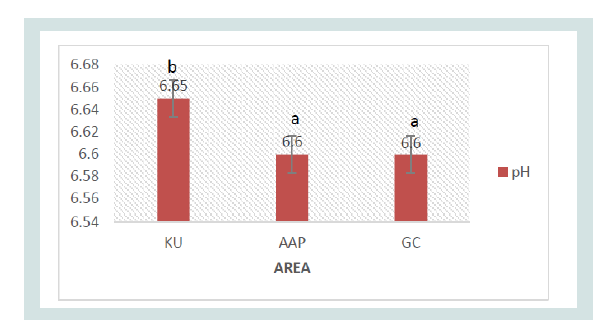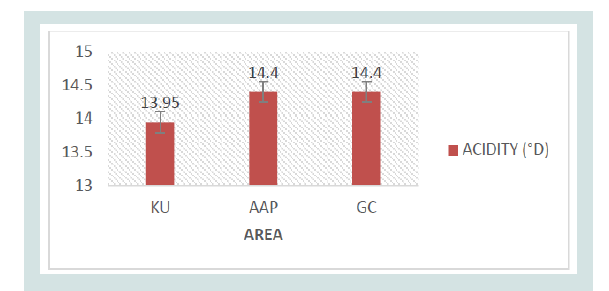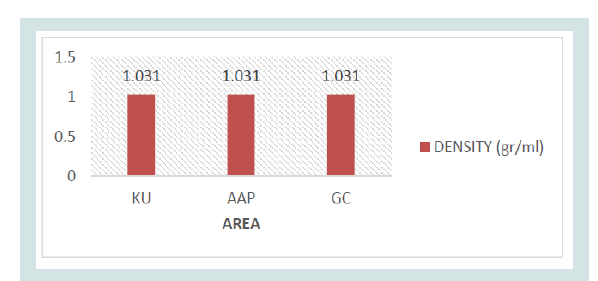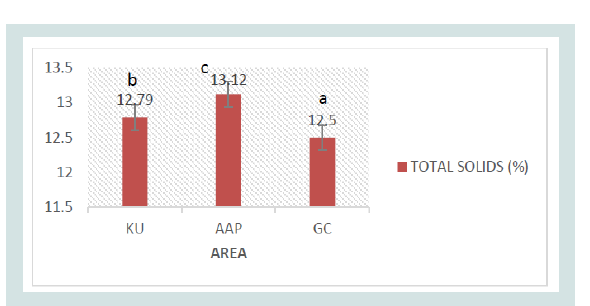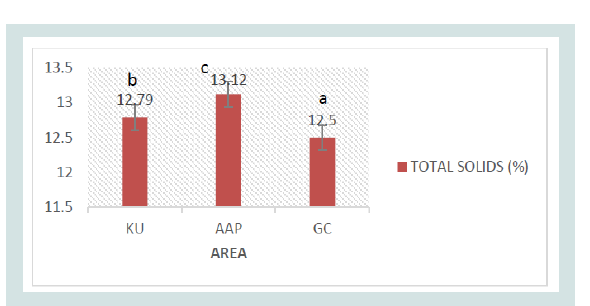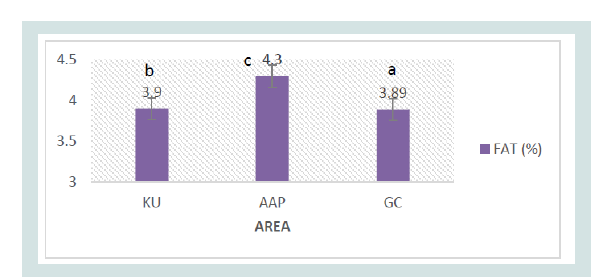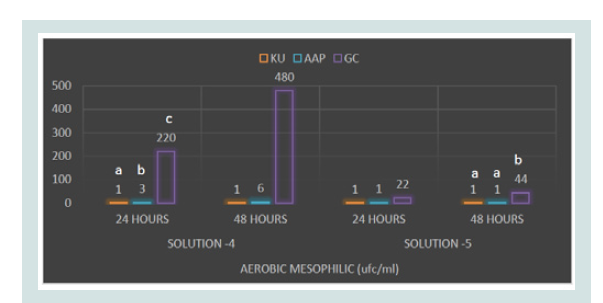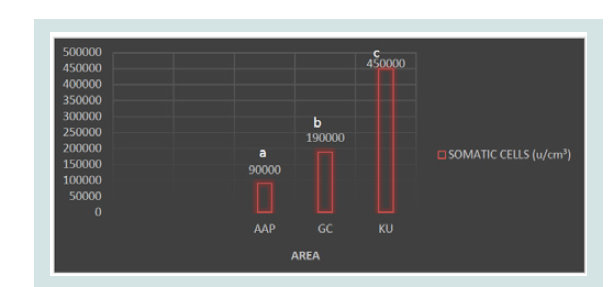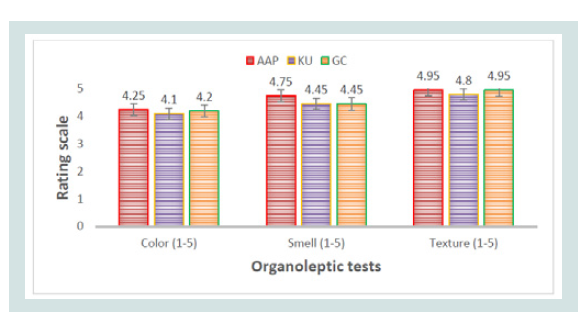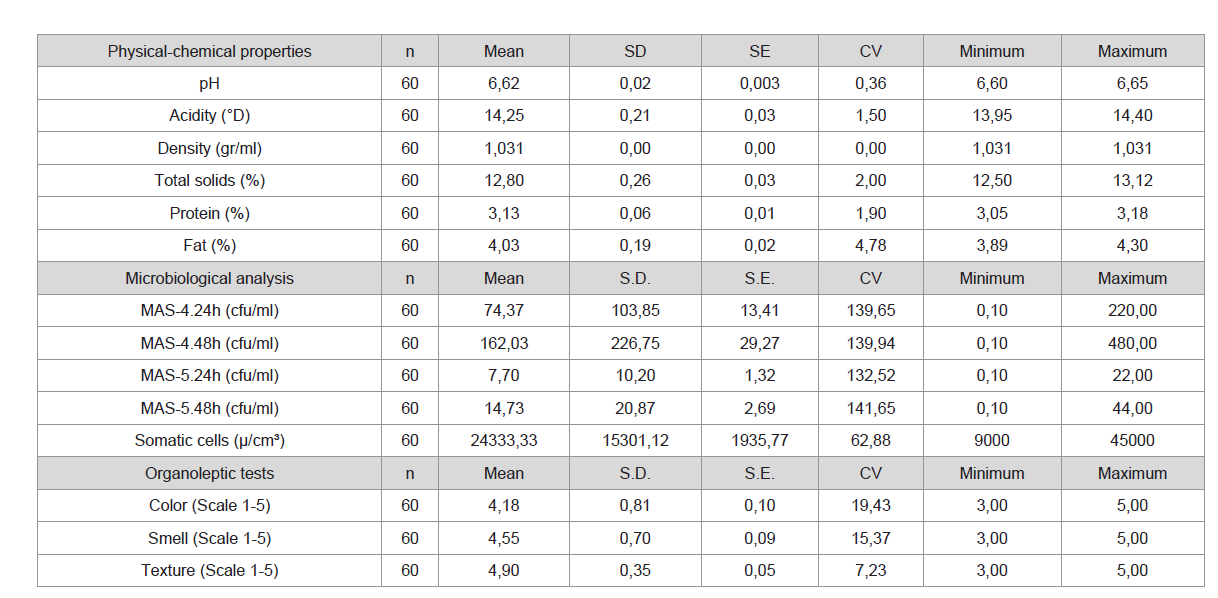Journal of Veterinary Science & Medicine
Download PDF
Research Article
Evaluation of the Quality of Bovine Milk of the Livestock Farms of Suscal, Cañar, Ecuador
Heredia Peralta DT1,3, Simbaina Solano JC2*
1Dairy Technician “Ambrosio Andrade Palacios”. Cañar, Ecuador.
2Assitant researcher “University of Azuay”. Cuenca, Ecuador.
3Laboratory of Bromatology and Microbiology “NUTRI Leche” of
Dairy “San Antonio”
*Address for correspondence:
Simbaina Solano JC, Assistant researcher “University of Azuay”
Cuenca, Ecuador. Lanimetry Laboratory, Faculty of Veterinary and
Animal Sciences, University of Chile, Santa Rosa 11735, Santiago,
Chile. E-mail: austrogenetica@gmail.com
Submission: 25-November-2019
Accepted: 28-December-2019
Published: 30-December-2019
Copyright: © 2019 Heredia Peralta DT, et al. This is an open access
article distributed under the Creative Commons Attribution License,
which permits unrestricted use, distribution, and reproduction in any
medium, provided the original work is properly cited.
Abstract
Cow’s milk is an integral product that provides essential nutrients
for health, and it is consumed worldwide. In Ecuador, the INEN
9:2015 (Ecuadorian Institute for Standardization), standards establish
quality standards for production, distribution and marketing. They
are supervised by Agrocalidad and ARCSA, which guarantees that
the milk is fit for consumption. However, these practices are unknown
to small producers. Therefore, in the present study, the milk quality
(physicochemical properties, microbiological analysis and organoleptic
tests) was determined in different rural areas of Suscal livestock farms,
province of Cañar. The data was analyzed using a multifactorial
ANOVA using SAS. The separation of means, the Tukey test was used
at a significance level (P<0,05). And the Pearson correlation test
was performed. The results were, in physicochemical properties: the
average acidity of 14.25 °D; protein of 3.13 %; and fat of 4.03 %. In the
microbiological analysis: the mesophilic aerobes in solution -4 were
74.37 CFU and 162.03 CFU at 24 and 48 hours respectively; and somatic
cells of 243333.33 u/cm³. In organoleptic characteristics: the color was
opalescent white and slightly yellowish; the smell was milky smooth and
free of strange odors; and the texture of the milk was homogeneous
and free of foreign matter. Finally, total solids are highly correlated with
protein and fat, which is positive.
Keywords
Quality; bovine milk; physicochemical; microbiological; organoleptic
Introduction
Milk is the indispensable food of newborn mammals, considered
one of the most complete foods, and the composition of nutrients
is balanced [1]. As for cow’s milk, it is an integral food, which is
consumed worldwide, which is very beneficial for humans, especially
for children; due to the amount of nutrients it contains [2]. In Ecuador,
there are geographical areas suitable for the production of bovine
milk, and the sierra region constitutes the main producing region;
which is distributed nationwide [3]. The province of Cañar, located
in the south central zone, also contributes with important quantities
in the production of national bovine milk [4]. Within the province, in
the town of Suscal, numerous families are linked to this activity, where
villagers from rural areas market the product in their own sector or it
is sold to the processing plants, through which they obtain their main
economic benefits [5]. The production, transport and marketing
of milk in the country is supervised by Agrocalidad and ARCSA
(National Agency for Regulation, Control and Sanitary Vigilance).
The price of milk in the market of the Suscal town is around 0.25
to 0.30 cents (USD), depending on the supply by the intermediaries,
however, there are dairies that pay for milk according its quality;
based on the percentages of fat and protein [6]. On the other hand,
the quality also implies the presence of pathogenic microorganisms,
which, the milk, besides being a healthy and beneficial product, also
constitutes as a culture medium for the microorganisms, in this way,
constituting itself as a way of transmission of diseases [7]. However,
several producers in the town of Suscal don’t know about the quality
of bovine milk, due to its high cost for the laboratory analysis as well
as not knowing if the milk is suitable for consumption. Therefore,
through the present study, it was proposed to determine the quality of bovine milk in the premises of the town of Suscal, establishing
3 sample collection areas: area 1 (Kolla Uko); area 2 (Ambrosio
Andrade Palacios); area 3 (Gun Chico). For which, the following
specific objectives were established: to carry out the physicochemical
and microbiological analysis and organoleptic tests of bovine milk.
Materials and Methods
The present research work was carried out in different livestock
herds of the Suscal farms. This town is located on the Durán-Tambo
section of the Pan-American Highway in the province of Cañar,
at an altitude of 2720 meters above sea level [8]. The research is
descriptive and the experimental units are the cattle herds, where the
physical, chemical, microbiological and organoleptic variables of the
bovine milk were evaluated. The study areas were: Kulla Uko (KU),
Ambrosio Andrade Palacios (AAP) and Gun Chico (GC), where milk
samples were collected approximately 500 ml per livestock farm, and
with twenty repetitions per area.
Laboratory analysis: The pH of the milk was measured with the pH meter. Cow’s milk
has a weakly acid reaction, with a pH between 6.6 and 6.8; as a result
of casein and phosphoric and citric anions [9,10]. Additionally, the
acidity was determined using phenolphthalein and sodium hydroxide,
where a 10 ml milk sample was taken in a beaker, then 3 drops of the
phenolphthalein indicator was added to 1 %, then sodium hydroxide
was added on the dissolution until its turn [11]. According to the
NTE INEN 9-13 test of normal raw milk, the acidity must be between
minimum 0.13 % or 13 °D and maximum 0.17 % or 17 °D. The degree
of acidity demonstrates the level of microbial contamination that
milk has [12]. On the other hand, the density, total solids, protein and
fat were determined using the Ekomilk equipment [11], where 100
ml of milk was placed, and subsequently, its corresponding reading.
According to the NTE INEN 9-11 standard raw milk test, the relative
density must be between minimum 1.028 g/ml to 1.029 g/ml at 15
and 20 °C respectively, and between maximum 1.032 g/ml to 1.033 g/
ml at 15 and 20 °C respectively. Additionally, according to the NTE
INEN 9-14 standard raw milk test, total solids must be minimum 11.2
%. Also, according to the NTE INEN 9-16 assay of normal raw milk,
the protein must be minimum 2.9 %. Finally, according to the NTE
INEN-ISO 2406 test of normal raw milk, the fat must be minimum
3.0 % [12].
In the cultivation of mesophilic aerobes [13], 1 ml of the milk
sample was taken in a test tube and 0.1 % peptone water was added,
then it was homogenized, and subsequently, solutions D-4 and D-5
were made. Finally, 1 ml of each solution was placed in the aerobic
profiles for their respective culture at 24 and 48 hours in the stove at 31
°C. The observation of the pink colonies in the profiles is an indicator
of the presence of mesophilic aerobes, and the report is through
the counting of the colonies in 1 cm² [14]. According to the NTE
INEN 1529-5 standard milk test, the aerobic colony count must be
maximum 2x10⁴ to 5x10⁴ CFU [12]. The Colony Forming Unit (CFU)
in raw milk represents each growing colony of bacterial and fungal
cells (fungi). Each colony represents a dozen million descendant
cells [15]. Bacteria grow in pairs (diplococci), chain (streptococci) or
clusters (staphylococci) [16]. Among the main bacteria that develop
in fresh milk are E. coli and Listeria monocytogenes [13]. On the
other hand, the EKOMILK somatic cells analyzer team [14] was
used to determine the number of somatic cells, where 10 ml of milk
was placed with 5 ml of the EKOPRIM reagent, and subsequently its
respective reading. According to ISO 13366-1 standard milk test, the
somatic cell count must be less than 5x10⁵ u/ml [12,17]. The number
of somatic cells in raw milk is an indicator of leukocytes present in
the mammary gland, which represents the health status of the udder
[14,18].
Finally, the organoleptic characteristics of bovine milk, was
determined following the INEN 9: 2015 standards, where, the said
norm establishes the ideal characteristics of a normal milk (color,
smell and texture). For the evaluation of the evaluated variables, a
scale of 1 to 5 was used, where 1 indicates a lower valuation (not
ideal milk) and 5 the highest valuation (ideal milk). According to
the norm NTE INEN 9: 2015 of the normal raw milk, the color must
be opalescent white and slightly yellowish; the smell must be soft,
characteristic milk and free of strange odors; and the texture must be
homogeneous and free of foreign matters.
Statistical analysis: The data obtained were subjected to a multifactorial ANOVA
using SAS software (Statistic Analysis Software) [19], where the
factors of study were the different livestock farms areas and the
evaluation variables were physicochemical, microbiological and
organoleptic properties of bovine milk. For the separation of means,
Tukey test was used at the level of significance (P<0.05). Additionally,
Pearson’s correlation test was used among the variables evaluated.
Results
The general averages of physicochemical properties,
microbiological analysis and organoleptic tests in Suscal livestock
farms were detailed below (Table 1
).
Physicochemical analysis per area: The pH of the milk was of 6.65 in Kulla Uko area (KU); of 6.6
in Ambrosio Andrade Palacios area (AAP); and of 6.6 in Gun Chico
area (GC), with significant differences (P<0.05), (Figure 1
).
The acidity of the milk was 13.95 °D in KU; of 14.4 °D in AAP;
and 14.4 °D in GC, without statistical differences (Figure 2
).
The density of the milk in the areas KU, AAP and GC was 1.031
gr/ml, without significant differences (Figure 3
).
The total solids of the milk were of 12.79 % in KU; of 13.12 %
in AAP; and of 12.5 % in GC, with significant differences (P<0.05),
(Figure 4
).
The milk protein was 3.18 % in KU; of 3.17 % in AAP; and 3.05 %
in GC, without statistical differences (Figure 5
).
The milk fat was of 3.9 % in KU; 4.3 % in AAP; and of 3.89 % in
GC, with significant differences (P<0.05), (Figure 6
).
Microbiological analysis per area: The count of the colonies for mesophilic aerobes with solution
-4 at 24 hours were 1; 3 and 220 colonies in KU, AAP and GC
respectively, with significant differences (P<0.05). Meanwhile, with
the same solution -4 at 48 hours were 1; 6 and 480 colonies in KU,
AAP and GC respectively, without significant differences. On the
other hand, the count of colonies for mesophilic aerobes with the
-5 solution at 24 hours were 1; 1 and 22 colonies in KU, AAP and
GC respectively, without significant differences. Meanwhile, with the
same solution -5 at 48 hours were 1; 1 and 44 colonies in KU, AAP
and GC respectively, with significant differences (P<0.05) (Figure 7).
The count of the somatic cells in the raw milk were < 90e3, 190e3
and 450e3 u/cm³ in the areas AAP, GC and KU respectively, with
significant differences (P<0.05) (Figure 8
).
Organoleptic test per area: The color of the raw milk had a value of 4.25 points in AAP; 4.1
points in KU; and 4.2 points in GC, without significant differences.
The odor of raw milk had a value of 4.75 points in AAP; 4.25 points
in KU; and 4.45 points in GC, without significant differences. The
texture or appearance of the raw milk had a value of 4.95 points in
AAP; 4.8 points in KU; and 4.95 points in GC, without significant
differences (Figure 9
).
Correlation between the variables: Total solids are highly correlated with the protein at 0.81 (P<0.01)
and with fat at 0.89 (P<0.01), and they are positive. On the other
hand, protein and fat are fairly correlated at 0.46 (P<0.01), and it´s
positive (Table 2
).
Discussion
The physical and chemical characteristics of bovine milk, the pH
of raw milk must be between 6.6 and 6.8 [9]. Arteaga (2016) reports
the pH after making an improvement plan with the San Antonio
dairy suppliers, with values of 6.69. In our results, 6.62 were reported.
On the other hand, according to the NTE INEN 9-13 test of normal raw milk, the acidity must be between minimum 0.13% (13
°D) to 0.17% (17 °D) [12]. Arteaga (2016) reports the acidity of 14.41
°D in San Antonio dairy products, and Quevedo (2019) of 0,15 °D. In
our results, 14.25 °D was reported. Therefore, our results are similar
to the reports of Arteaga (2016) and Quevedo (2019), and are within
the ranges established by the INEN 9: 2015 standard.
Table 1: General averages of physicochemical properties, microbiological analysis and organoleptic tests in Suscal livestock farms.
Additionally, according to the NTE INEN 9-11 standard raw milk
test, the relative density must be at a minimum of 1.029 g/ml to 1.028
g/ml at 15 and 20 °C respectively, and must be at a maximum of 1.032
g/ml to 1,033 g/ml at 15 and 20 °C respectively [12]. Arteaga (2016),
reports the density 1.030 g/ml, and Quevedo (2019) of 1,029 g/ml. In
our results, 1.031 g/ml was reported. Therefore, our results are similar
to the reports of Arteaga (2016) and Quevedo (2019), and are within
the range established by the INEN 9: 2015 standard.
In addition, according to the NTE INEN 9-14 trials; NTE INEN
9-16; and INEN-ISO 2406 of normal raw milk for total solids; protein;
and fat, must be at least 11.2%; 2.9%; 3.0% respectively [12]. Arteaga
(2016) and Quevedo (2019) report similar data. In our results we
obtained percentages higher than these ranges, which indicates that
they comply with the INEN 9: 2015 norm.
Regarding the microbiological analysis of bovine milk, according
to the NTE INEN 1529-5 test of normal raw milk, the aerobic colony
count must be maximum of 2x10⁴ to 5x10⁴ CFU [12]. Our results
report lower data with respect to the norm INEN 9: 2015, which
indicates, a milk without major contamination. On the other hand,
according to the ISO 13366-1 test of normal raw milk, the somatic
cell count must be less than 5x10⁵ u/ml [12]. Our results report below
of INEN 9: 2015 and Quevedo (2019), which indicates that the health status of the udders was not very infected by pathogens which ensures
a quality milk that can be consumed by the population.
As regards the organoleptic characteristics of bovine milk,
according to the NTE INEN 9: 2015 norm of normal raw milk, the
color must be opalescent white and slightly yellowish; the smell
must be soft dairy characteristic and free of strange smells; and the
texture must be homogeneous and free of foreign matters [20,21].
Our results report scores of 4.18; 4.55; and 4.90 in color, smell, and
texture respectively. Therefore, the organoleptic characteristics of the
analyzed milk had values about 5, that is, values that indicate an ideal
milk, with qualities of texture, color and smell of a normal milk, fresh
and suitable for consumption.
Conclusion
The microbiological analysis of bovine milk, by counting the
Colony Forming Units (CFU) to determine mesophilic aerobes, our
results do not ensure that the product is free of pathogens. Therefore,
a specific analysis for each pathogen is recommended for future
studies. However, by counting microorganism-forming colonies,
we can verify a priori the degree of microbial contamination, and thus, diagnose the quality of the product. Additionally, through the
analysis of somatic cells, our result doesn´t specify the pathogen
contaminating the udders. In addition, the Kulla Uko (KU) area
reports high amounts of somatic cells, about to the maximum limit
recommended by the INEN 9: 2015 norm, although it doesn´t differ
statistically, consequently, it presents risks and dangers of propagation
of these pathogens.
The organoleptic characteristics of the milk are fundamental
to determine the quality of the product, since the product is
highly perishable and captures strong and strange smells from the
environment. Therefore, the analysis of the organoleptic tests is
fundamental to determine the quality of the product. Additionally, it is
recommended to consume the milk duly treated under pasteurization
and sterilization techniques, since the fresh and raw product presents
risks of contamination and transmission of diseases. Finally, the cost
of analysis in the laboratory was $ 50.00 (USD) per sample.


